Analys
SHB Råvaruplanket 13 december 2012
 Nytt år med tillförsikt
Nytt år med tillförsikt
Positivt risksentiment efter nyår
Kinas ekonomi befinner sig i början av en konjunkturvändning som andas optimism. När USA lägger fiscal cliff motvinden bakom sig efter nyår kommer en ”uppdämd” positiv konjunkturstuds på andra sidan Atlanten. Europa signalerade bottenkänning i tysk industri under november. Någon snabb återhämtning blir det inte tal om med tanke på bred finanspolitisk åtstramning och fortsatt djup recession i Sydeuropa. ECB fortsätter också utgöra en begränsning på nedsidan mot finansiell oro.
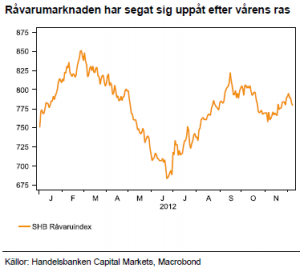 Fortsatt expansiv penningpolitik
Fortsatt expansiv penningpolitik
Centralbankerna har haft en betydande roll för höstens rally i råvaror. Penningpolitiken har eliminerat domedagsscenariot för världsekonomin men har inte lyckats mota den låga tillväxten. De tre största har nu laddat om och efter att Fed utökat QE så ökar trycket på Japans centralbank att följa i samma spår, efter valet, den 19-20:e december. Som grädde på moset öppnade ECB dörren för räntesänkning. Nästa möjlighet är 10:e januari.
Inga stora förändningar i vår syn på råvarorna
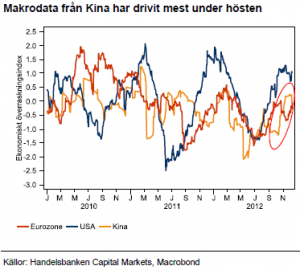 Makroekonomiskt går vi mot ett nytt kvartal mycket likt det vi snart lämnar bakom oss. Därför gör vi inga stora förändringar i vår syn. Vi ser oljemarknaden som väl balanserad och väntar oss fortsatt handel i intervallet 95-120 USD med en prognos på 110 USD för H1 2013. Oron i Mellanöstern kommer vara den tillfälliga drivkraften uppåt. Kinas konjunkturuppgång ger stöd åt råvaror i allmänhet och åt basmetaller i synnerhet och vi fortsätter tro på högre priser, men nu mer selektivt, och med koppar som favoritmetall. I förra ”Planket” sänkte vi vete, soja och majs. Soja och majs har kommit på fall medan vete fått stöd av dålig etablering av höstsådden i USA. Vi ser de höga priserna som tillfälliga och tror på lägre priser framåt vårkanten. Vete har störst fallhöjd men också störst risk på uppsidan.
Makroekonomiskt går vi mot ett nytt kvartal mycket likt det vi snart lämnar bakom oss. Därför gör vi inga stora förändringar i vår syn. Vi ser oljemarknaden som väl balanserad och väntar oss fortsatt handel i intervallet 95-120 USD med en prognos på 110 USD för H1 2013. Oron i Mellanöstern kommer vara den tillfälliga drivkraften uppåt. Kinas konjunkturuppgång ger stöd åt råvaror i allmänhet och åt basmetaller i synnerhet och vi fortsätter tro på högre priser, men nu mer selektivt, och med koppar som favoritmetall. I förra ”Planket” sänkte vi vete, soja och majs. Soja och majs har kommit på fall medan vete fått stöd av dålig etablering av höstsådden i USA. Vi ser de höga priserna som tillfälliga och tror på lägre priser framåt vårkanten. Vete har störst fallhöjd men också störst risk på uppsidan.
Basmetaller
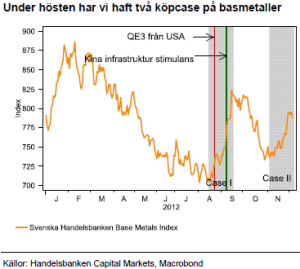 Kina har vänt – ”äntligen”
Kina har vänt – ”äntligen”
Ekonomiska indikatorer från Kina har stärks under senaste tiden. Expansiv penningpolitik under de senaste 12 månaderna i kombination med de så viktiga investeringarna i infrastruktur har slutligen vänt inbromsningen. Tydligast märks det i tung industri, produktion av el och stål har stigit anmärkningsvärt. Priset på järnmalm och stål har följaktligen studsat upp efter lågvattenmärket i augusti.
Slut på lagerutrensningen
Tittar vi längre ner i tillverkningskedjan har kinesisk tillverkningsindustri haft ett tufft år, speciellt för konsumtionsvaror. Produktionen av luftkonditioneringar föll med 11% fram till oktober medan tillverkningen av vitvaror och mobiltelefoner visade obetydlig tillväxt. I takt med att ekonomin bromsade in slog tillverkarna av på tempot och sålde ut färdiga enheter från lager. Lagernivåerna av luftkonditioneringar har nu fallit från 12 miljoner enheter i december 2011 till 5,9 miljoner enheter i början av hösten. En jämförlig trend återfinns bland de flesta segment och Kina står inför en uppgång i konjunkturen i kombination med påfyllnad av lagercykeln.
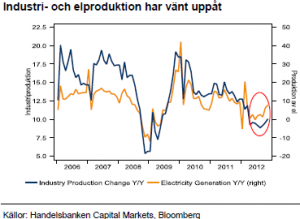 Är koppar näst på tur?
Är koppar näst på tur?
Basmetallerna har svängt kraftigt under året. Basmetaller är en enkel investering för investerare som söker utväxling på Kinas aktivitet och lockar därför stora investeringsflöden. Under hösten har vi sett prov på hur detta slår åt båda håll. Positiva tecken från Kina handlas omgående in i priserna på basmetaller och det är därför befogat att fundera över vad som ska röra sig mest framöver, efter det senaste rallyt. Utgår man ifrån 2012 års bottnar har koppar stigit 10%, nickel 16%, zink 17%, aluminium 17%, bly 30% och tenn 32%. Bottennivåerna brukar spegla den fundamentala balansen mellan utbud och efterfrågan bättre än toppnivåerna och med det resonemanget är det koppar av basmetallerna som ska gå bäst under Q1. Vi har 8800 USD som mål för våra strategier med koppar, jämfört med dagens 8082.
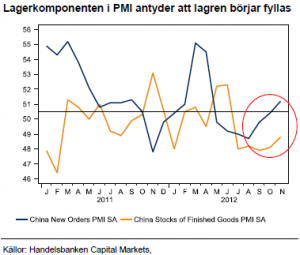 Som investerare kan man söka avkastning genom att köpa koppar och sälja basmetallkorgen eller, för den som kan handla optioner, med en ratio spread. I båda fallen har man visst skydd om marknaden skulle falla även om den första strategin endast fokuserar på relativavkastningen mellan koppar och basmetallerna. Vi tycker att ett skydd på nedsidan är på sin plats efter att basmetallerna redan stigit mycket i pris.
Som investerare kan man söka avkastning genom att köpa koppar och sälja basmetallkorgen eller, för den som kan handla optioner, med en ratio spread. I båda fallen har man visst skydd om marknaden skulle falla även om den första strategin endast fokuserar på relativavkastningen mellan koppar och basmetallerna. Vi tycker att ett skydd på nedsidan är på sin plats efter att basmetallerna redan stigit mycket i pris.
Energi
Kartellens styrka tvinar
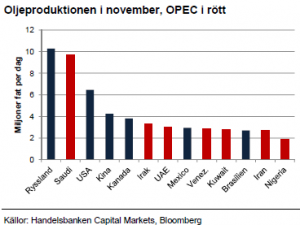 Efter att Iran effektivt stoppats ur exportmarknaden för olja har OPEC:s kraft försvagats ytterligare. Idag är bara en av världens fem största oljeproducenter medlem i OPEC. Många icke OPEC-länder har ökat produktionen. USA, Kanada och Mexico producerar nu mer olja än de tre största OPEC-/Mellanösternländerna; Saudi, Irak och Iran. Under OPEC-mötet i december förra året ändrades systemet med medlemsbaserade produktionskvoter till en sammanlagd OPEC-kvot. Denna har legat på 30 miljoner fat per dag sedan dess men verkar i praktiken som ett golv snarare än ett tak då produktionen hela tiden överstigit kvoten.
Efter att Iran effektivt stoppats ur exportmarknaden för olja har OPEC:s kraft försvagats ytterligare. Idag är bara en av världens fem största oljeproducenter medlem i OPEC. Många icke OPEC-länder har ökat produktionen. USA, Kanada och Mexico producerar nu mer olja än de tre största OPEC-/Mellanösternländerna; Saudi, Irak och Iran. Under OPEC-mötet i december förra året ändrades systemet med medlemsbaserade produktionskvoter till en sammanlagd OPEC-kvot. Denna har legat på 30 miljoner fat per dag sedan dess men verkar i praktiken som ett golv snarare än ett tak då produktionen hela tiden överstigit kvoten.
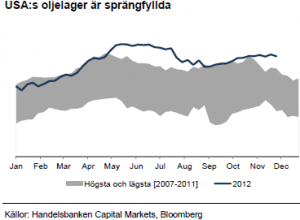 Bland de få saker OPEC-länderna är överens om så står det klart att efterfrågan på kartellens olja kommer minska under 2013. OPEC kommer säkerligen att tvingas sänka kvoten för att stabilisera priset som respons på ökad produktion utanför OPEC-länderna och fortsatt svag tillväxt i Europa och USA. Vägen dit kommer föregås av prisfall.
Bland de få saker OPEC-länderna är överens om så står det klart att efterfrågan på kartellens olja kommer minska under 2013. OPEC kommer säkerligen att tvingas sänka kvoten för att stabilisera priset som respons på ökad produktion utanför OPEC-länderna och fortsatt svag tillväxt i Europa och USA. Vägen dit kommer föregås av prisfall.
Oljemarknaden är väl försörjd
Sedan förra ”Råvaruplanket” i mitten av september har oljemarknadens fundamenta successivt försvagats och priset har rört sig i en fallande kanal. Säsongsmässigt är det en svag tid på året, efter ”driving season” och före norra halvklotets vinter. Även om Iran och Syrien adderar riskpremie så har denna successivt minskat sedan Israels premiärminister Netanyahu göt olja på vågorna genom att flytta fram tidshorisonten för militärt våld som medel att avfärda Irans möjligheter att skaffa kärnvapen från denna höst till våren eller sommaren. Riskerna för högre oljepris under kommande halvår ligger därmed kvar med Israel som centrum, annars tror vi riskpremien fortsätter pysa ur priset.
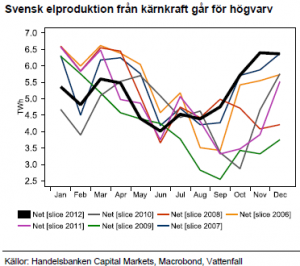 Nu handlar SHB El mot Q2 terminspris
Nu handlar SHB El mot Q2 terminspris
Alla grundläggande fundamenta talar fortfarande för låga elpriser; mycket vatten i magasinen inför vintern, låga kolpris, lågt pris på utsläppsrätter och en situation för kärnkraften som ser ovanligt bra ut. Dessa fundamenta är också inprisat i terminskurvan som handlas på riktigt låga nivåer. Prisrörelserna följer därmed väderleksrapporten och bjuder på snabba vändningar för den tradingorienterade.
Ädelmetaller
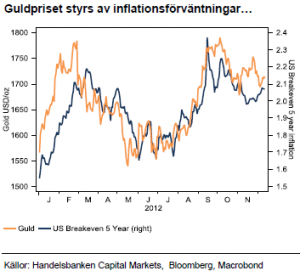 ECB och Fed skapade guld-rally
ECB och Fed skapade guld-rally
Sedan vi i förra ”Råvaruplanket” intensifierade vår tro på stigande priser på guld och silver så har guld och inflationsförväntningarna, drivna av USA:s QE program toppat ur. Stimulanser från EU och USA förväntades och prisades in under augusti och september. När stimulanserna lanserats enligt förväntningarna har priserna åter fallit tillbaka.
Vi förväntar oss fortfarande stigande priser men drar ner intensiteten i tron på högre priser på ädelmetaller. Kommande prisuppgång kommer drivas av förnyad oro för inflation från mer monetär stimulans från de stora centralbankerna tillsammans med volatilitet i valutorna.
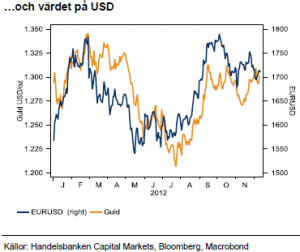 Resultatet från det amerikanska presidentvalet ger också stöd åt guldpriset. President Obama vid rodret skapar förutsättningar för fortsatt extremt expansiv penningpolitik.
Resultatet från det amerikanska presidentvalet ger också stöd åt guldpriset. President Obama vid rodret skapar förutsättningar för fortsatt extremt expansiv penningpolitik.
Stort bortfall av platina
De stora bolagen kämpar fortfarande med produktionsstörningar i spåren av strejkerna i Sydafrikas gruvindustri. Höjda löner har temporärt löst en del av problemen men bolagen anför att löneökningarna frestare lönsamheten i de lågt mekaniserade gruvorna. Speciellt gruvbolaget Lonmin har fått finansiella problem i kölvattnet av produktionsbortfall och kostnadsökningar.
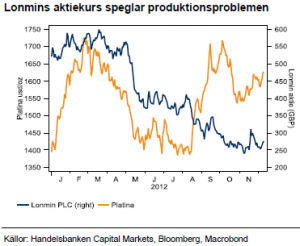 Bolagsproblemen kommer att återspeglas i framtida produktion och industrin kommer långsiktigt att få svårt att upprätthålla den historiska produktionstakten med mindre än att nyinvesteringar kommer på plats. Tumultet i Sydafrika som står för 76 % av globala produktionen av platina har startat en spiral som kräver högre priser för att försörja marknaden med platina. Efterfrågan är god trots krisen i Europeisk bilindustri. Kinesisk dito accelererar och parat med allt starkare klimatkrav i Asien så krävs mer platina till den växande fordonsparkens katalysatorer.
Bolagsproblemen kommer att återspeglas i framtida produktion och industrin kommer långsiktigt att få svårt att upprätthålla den historiska produktionstakten med mindre än att nyinvesteringar kommer på plats. Tumultet i Sydafrika som står för 76 % av globala produktionen av platina har startat en spiral som kräver högre priser för att försörja marknaden med platina. Efterfrågan är god trots krisen i Europeisk bilindustri. Kinesisk dito accelererar och parat med allt starkare klimatkrav i Asien så krävs mer platina till den växande fordonsparkens katalysatorer.
Jordbruk
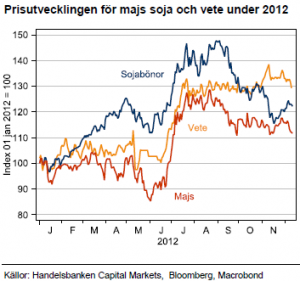 Efter solsken kommer…mer solsken
Efter solsken kommer…mer solsken
Den värsta torkan i USA sedan 1956 förstörde mellan 12-15 % av den amerikanska soja- och majsskörden. Vetets odlingsår ligger tidigare och var mestadels redan skördat. Bristen på majs drev upp priset på vete som kan ersätta majs som djurfoder. När nu nästa års vete är sått och sakteliga går mot vintervila har det åter varit torrare än normalt under november i USA som står för vart tredje ton spannmål på exportmarknaden. Rapporterna om dålig etablering av höstvete i USA och Ryssland har gett vete ytterligare en skjuts uppåt på börsen och därmed också begränsat prisfallet på majs. Soja och majs har ändå antagit en fallande trend.
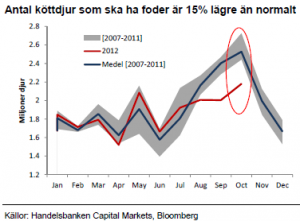 Senaste USDA-rapporten
Senaste USDA-rapporten
I veckan kom senaste rapporten från amerikanska jordbruksdepartementet. Utgående lager för odlingsåret 12/13 justerades upp för vete och majs då stigande produktion utanför USA kompenserar för USA:s dåliga skick på grödorna. Kina och Kanada prognostiseras få rekordskörd efter att de höga priserna gett incitament att öka odlingsarealen och länderna har dessutom haft gynnsamt väder. Efterfrågan för vete och majs justerades ner då de höga priserna minskar efterfrågan till djurfoder. Grafen till höger illustrerar hur många köttdjur som behöver foder i USA. I år är det 15 % mindre djur som kräver foder under vintern då djuren tas in till stall efter betessäsongen. Detta återspeglar den dåliga kalkyl det innebär att föda upp djuren på dyr spannmål med nuvarande köttpriser.
 ”Vete är ett ogräs” Mateus 13:24-30
”Vete är ett ogräs” Mateus 13:24-30
Vår analys visar att ”sämre än vanligt” skick på grödorna vid den här tiden på året har låg korrelation med hur skörden verkligen blir. Den viktigaste perioden är under våren då grödorna kräver mycket vatten. Vete tenderar också att återhämta sig bättre än andra grödor från en dålig start.
Som resultat tror vi att priset på nästa års veteskörd har potential att falla dramatiskt. Just nu handlas december 13 vete på högre nivåer än december 12, trots att utgående lager 13/14 prognostiseras högre än utgående lager 12/13. Det finns alltså en ordentlig riskpremie i vetepriset, speciellt i USA (se terminskurvan till höger) och vi tror att priserna kommer falla i takt med att rädslan för brist avklingar.
[box]SHB Råvaruplanket är producerat av Handelsbanken och publiceras i samarbete och med tillstånd på Råvarumarknaden.se[/box]
Ansvarsbegränsning
Detta material är producerat av Svenska Handelsbanken AB (publ) i fortsättningen kallad Handelsbanken. De som arbetar med innehållet är inte analytiker och materialet är inte oberoende investeringsanalys. Innehållet är uteslutande avsett för kunder i Sverige. Syftet är att ge en allmän information till Handelsbankens kunder och utgör inte ett personligt investeringsråd eller en personlig rekommendation. Informationen ska inte ensamt utgöra underlag för investeringsbeslut. Kunder bör inhämta råd från sina rådgivare och basera sina investeringsbeslut utifrån egen erfarenhet.
Informationen i materialet kan ändras och också avvika från de åsikter som uttrycks i oberoende investeringsanalyser från Handelsbanken. Informationen grundar sig på allmänt tillgänglig information och är hämtad från källor som bedöms som tillförlitliga, men riktigheten kan inte garanteras och informationen kan vara ofullständig eller nedkortad. Ingen del av förslaget får reproduceras eller distribueras till någon annan person utan att Handelsbanken dessförinnan lämnat sitt skriftliga medgivande. Handelsbanken ansvarar inte för att materialet används på ett sätt som strider mot förbudet mot vidarebefordran eller offentliggörs i strid med bankens regler.
Analys
Tightening fundamentals – bullish inventories from DOE

The latest weekly report from the US DOE showed a substantial drawdown across key petroleum categories, adding more upside potential to the fundamental picture.

Commercial crude inventories (excl. SPR) fell by 5.8 million barrels, bringing total inventories down to 415.1 million barrels. Now sitting 11% below the five-year seasonal norm and placed in the lowest 2015-2022 range (see picture below).
Product inventories also tightened further last week. Gasoline inventories declined by 2.1 million barrels, with reductions seen in both finished gasoline and blending components. Current gasoline levels are about 3% below the five-year average for this time of year.
Among products, the most notable move came in diesel, where inventories dropped by almost 4.1 million barrels, deepening the deficit to around 20% below seasonal norms – continuing to underscore the persistent supply tightness in diesel markets.
The only area of inventory growth was in propane/propylene, which posted a significant 5.1-million-barrel build and now stands 9% above the five-year average.
Total commercial petroleum inventories (crude plus refined products) declined by 4.2 million barrels on the week, reinforcing the overall tightening of US crude and products.


Analys
Bombs to ”ceasefire” in hours – Brent below $70

A classic case of “buy the rumor, sell the news” played out in oil markets, as Brent crude has dropped sharply – down nearly USD 10 per barrel since yesterday evening – following Iran’s retaliatory strike on a U.S. air base in Qatar. The immediate reaction was: “That was it?” The strike followed a carefully calibrated, non-escalatory playbook, avoiding direct threats to energy infrastructure or disruption of shipping through the Strait of Hormuz – thus calming worst-case fears.

After Monday morning’s sharp spike to USD 81.4 per barrel, triggered by the U.S. bombing of Iranian nuclear facilities, oil prices drifted sideways in anticipation of a potential Iranian response. That response came with advance warning and caused limited physical damage. Early this morning, both the U.S. President and Iranian state media announced a ceasefire, effectively placing a lid on the immediate conflict risk – at least for now.
As a result, Brent crude has now fallen by a total of USD 12 from Monday’s peak, currently trading around USD 69 per barrel.
Looking beyond geopolitics, the market will now shift its focus to the upcoming OPEC+ meeting in early July. Saudi Arabia’s decision to increase output earlier this year – despite falling prices – has drawn renewed attention considering recent developments. Some suggest this was a response to U.S. pressure to offset potential Iranian supply losses.
However, consensus is that the move was driven more by internal OPEC+ dynamics. After years of curbing production to support prices, Riyadh had grown frustrated with quota-busting by several members (notably Kazakhstan). With Saudi Arabia cutting up to 2 million barrels per day – roughly 2% of global supply – returns were diminishing, and the risk of losing market share was rising. The production increase is widely seen as an effort to reassert leadership and restore discipline within the group.
That said, the FT recently stated that, the Saudis remain wary of past missteps. In 2018, Riyadh ramped up output at Trump’s request ahead of Iran sanctions, only to see prices collapse when the U.S. granted broad waivers – triggering oversupply. Officials have reportedly made it clear they don’t intend to repeat that mistake.
The recent visit by President Trump to Saudi Arabia, which included agreements on AI, defense, and nuclear cooperation, suggests a broader strategic alignment. This has fueled speculation about a quiet “pump-for-politics” deal behind recent production moves.
Looking ahead, oil prices have now retraced the entire rally sparked by the June 13 Israel–Iran escalation. This retreat provides more political and policy space for both the U.S. and Saudi Arabia. Specifically, it makes it easier for Riyadh to scale back its three recent production hikes of 411,000 barrels each, potentially returning to more moderate increases of 137,000 barrels for August and September.
In short: with no major loss of Iranian supply to the market, OPEC+ – led by Saudi Arabia – no longer needs to compensate for a disruption that hasn’t materialized, especially not to please the U.S. at the cost of its own market strategy. As the Saudis themselves have signaled, they are unlikely to repeat previous mistakes.
Conclusion: With Brent now in the high USD 60s, buying oil looks fundamentally justified. The geopolitical premium has deflated, but tensions between Israel and Iran remain unresolved – and the risk of missteps and renewed escalation still lingers. In fact, even this morning, reports have emerged of renewed missile fire despite the declared “truce.” The path forward may be calmer – but it is far from stable.
Analys
A muted price reaction. Market looks relaxed, but it is still on edge waiting for what Iran will do

Brent crossed the 80-line this morning but quickly fell back assigning limited probability for Iran choosing to close the Strait of Hormuz. Brent traded in a range of USD 70.56 – 79.04/b last week as the market fluctuated between ”Iran wants a deal” and ”US is about to attack Iran”. At the end of the week though, Donald Trump managed to convince markets (and probably also Iran) that he would make a decision within two weeks. I.e. no imminent attack. Previously when when he has talked about ”making a decision within two weeks” he has often ended up doing nothing in the end. The oil market relaxed as a result and the week ended at USD 77.01/b which is just USD 6/b above the year to date average of USD 71/b.

Brent jumped to USD 81.4/b this morning, the highest since mid-January, but then quickly fell back to a current price of USD 78.2/b which is only up 1.5% versus the close on Friday. As such the market is pricing a fairly low probability that Iran will actually close the Strait of Hormuz. Probably because it will hurt Iranian oil exports as well as the global oil market.
It was however all smoke and mirrors. Deception. The US attacked Iran on Saturday. The attack involved 125 warplanes, submarines and surface warships and 14 bunker buster bombs were dropped on Iranian nuclear sites including Fordow, Natanz and Isfahan. In response the Iranian Parliament voted in support of closing the Strait of Hormuz where some 17 mb of crude and products is transported to the global market every day plus significant volumes of LNG. This is however merely an advise to the Supreme leader Ayatollah Ali Khamenei and the Supreme National Security Council which sits with the final and actual decision.
No supply of oil is lost yet. It is about the risk of Iran closing the Strait of Hormuz or not. So far not a single drop of oil supply has been lost to the global market. The price at the moment is all about the assessed risk of loss of supply. Will Iran choose to choke of the Strait of Hormuz or not? That is the big question. It would be painful for US consumers, for Donald Trump’s voter base, for the global economy but also for Iran and its population which relies on oil exports and income from selling oil out of that Strait as well. As such it is not a no-brainer choice for Iran to close the Strait for oil exports. And looking at the il price this morning it is clear that the oil market doesn’t assign a very high probability of it happening. It is however probably well within the capability of Iran to close the Strait off with rockets, mines, air-drones and possibly sea-drones. Just look at how Ukraine has been able to control and damage the Russian Black Sea fleet.
What to do about the highly enriched uranium which has gone missing? While the US and Israel can celebrate their destruction of Iranian nuclear facilities they are also scratching their heads over what to do with the lost Iranian nuclear material. Iran had 408 kg of highly enriched uranium (IAEA). Almost weapons grade. Enough for some 10 nuclear warheads. It seems to have been transported out of Fordow before the attack this weekend.
The market is still on edge. USD 80-something/b seems sensible while we wait. The oil market reaction to this weekend’s events is very muted so far. The market is still on edge awaiting what Iran will do. Because Iran will do something. But what and when? An oil price of 80-something seems like a sensible level until something do happen.
-

 Nyheter4 veckor sedan
Nyheter4 veckor sedanMahvie Minerals växlar spår – satsar fullt ut på guld
-

 Analys4 veckor sedan
Analys4 veckor sedanA muted price reaction. Market looks relaxed, but it is still on edge waiting for what Iran will do
-

 Nyheter3 veckor sedan
Nyheter3 veckor sedanJonas Lindvall är tillbaka med ett nytt oljebolag, Perthro, som ska börsnoteras
-

 Nyheter3 veckor sedan
Nyheter3 veckor sedanOljan, guldet och marknadens oroande tystnad
-

 Nyheter3 veckor sedan
Nyheter3 veckor sedanDomstolen ger klartecken till Lappland Guldprospektering
-

 Analys3 veckor sedan
Analys3 veckor sedanTightening fundamentals – bullish inventories from DOE
-

 Nyheter2 veckor sedan
Nyheter2 veckor sedanRyska staten siktar på att konfiskera en av landets största guldproducenter
-

 Nyheter2 veckor sedan
Nyheter2 veckor sedanSommarvädret styr elpriset i Sverige










